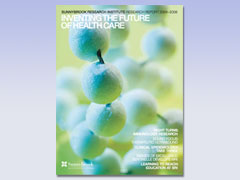Clinical Epidemiology: Take Three - Pritchard
It was Easter 2004, and Kathleen Pritchard was putting all of her eggs into one basket.
The head of clinical trials and epidemiology at TSRCC was on the phone with a pathologist in New Brunswick, imploring her to delve back into a decade-old inventory to uncover a specimen whose new examination, in Pritchard's hands, might reveal valuable information that was inaccessible when the samples were first pulled. Specifically, Pritchard needed her to sort through, prepare and mail some new "unstained" slides from a dozen women's stored pathology specimens. It was five or six hours of work, and the pathologist had come in on the holiday weekend to address Pritchard's request.
In the end, the study leader's passion, which was spilled out over the country across phone lines every Friday morning for three years, was enough to persuade sympathetic pathologists to send along 639 old tumour specimens (over 90% of those she sought) for the new life she would give them as part of a National Cancer Institute of Canada Clinical Trials Group (NCIC CTG) trial, whose Breast Cancer Site Group Pritchard co-chairs. (It's not surprising, says Dr. Maureen Trudeau, head of the division of medical oncology and hematology, who says of her colleague: "She has a great personality, she's fun loving, she's hard working, she's collegial and she's collaborative.")
Pritchard wanted to return to these specimens from the NCIC CTG Mammary.5 (MA.5) trial (archived in hospitals) in pursuit of her hypothesis that women with breast cancer with a positive incidence of a particular protein—Her-2/neu—would respond better to a certain kind of chemotherapy than women without.
Pritchard was able to prove that women with an overexpression of Her-2/neu (25% of those in the MA.5 trial) did much better if they received the dose-intensive anthracycline-containing regimens such as CEF (which uses a combination of cyclophosphamide, epirubicin and fluorouracil), while those without this overexpression seemed to do just as well with the less toxic CMF (cyclophosphamide, methotrexate and fluorouracil), the de-facto standard. In those whose tumours overexpressed Her-2/neu, she showed that CEF was better for both disease-free and overall survival.
Her findings, published in The New England Journal of Medicine in 2006, are significant, because they mean treatment can be more exactly tailored. CEF is more expensive, more toxic, puts its recipients at risk of more infection and side effects, and, importantly, exposes patients up to a 1% chance of contracting heart disease, and a 1% to 2% chance of getting leukemia. "With a marker like Her-2/neu," Pritchard says, "you can spare the patient who doesn't need the toxicity."
One of the challenges of this study—solved, in great part, by the willingness of the pathologist volunteers—was that it required the measuring of a gene that wasn't even known about when the patients consented to participate in the original. Partly as a result of this stumbling block, the national trials group has rewritten its privacy and ethics codes such that they now include a clear mechanism for allowing patients to give their permission for future tumour specimen reviews. "We're going to have a gold mine of material for long-term follow-ups and specimens," Pritchard says.
Her basket runneth over.
Pritchard's research was funded by the Canadian Breast Cancer Research Alliance and the Canadian Cancer Society through the National Cancer Institute of Canada. Infrastructure support was provided by the Canada Foundation for Innovation, Ontario Innovation Trust, and industry and private investment.
- Read the rest of Clinical Epidemiology: Take Three






